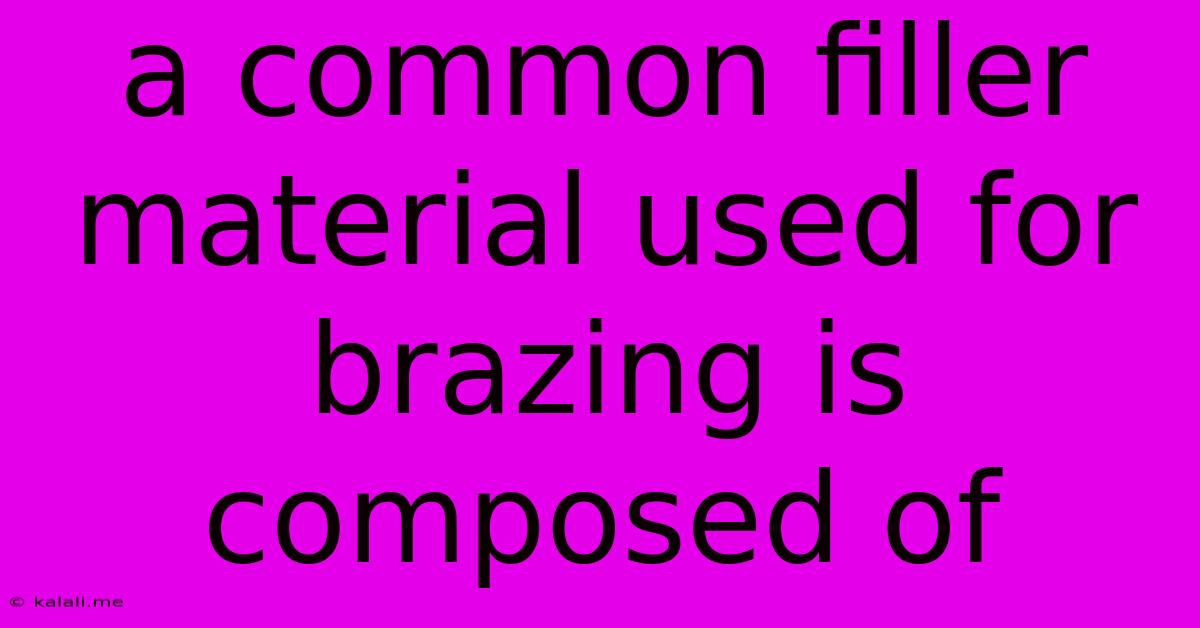A Common Filler Material Used For Brazing Is Composed Of
Kalali
Jun 13, 2025 · 3 min read

Table of Contents
A Common Filler Material Used for Brazing: Understanding Brazing Alloys
Brazing, a joining process that uses a filler metal with a lower melting point than the base metals, is crucial in various industries. This process creates a strong, reliable joint ideal for applications demanding high precision and strength. A common filler material used for brazing is composed of a variety of alloys, each tailored for specific applications based on their melting point, strength, and other properties. This article delves into the common compositions and characteristics of these filler materials.
What is Brazing Filler Metal?
Brazing filler metals are alloys specifically designed to melt and flow into the joint between two base metals. Unlike soldering, which uses a lower temperature filler, brazing uses a filler metal with a higher melting temperature, typically above 450°C (842°F). This higher temperature results in a stronger, more durable joint. The filler metal is drawn into the joint by capillary action, creating a strong metallurgical bond.
Common Compositions of Brazing Filler Materials
The composition of brazing filler materials varies greatly depending on the application's needs. However, some common base metals and elements are frequently used:
-
Copper-based alloys: These are among the most commonly used brazing filler metals. They offer excellent thermal and electrical conductivity, along with good corrosion resistance. Common additions include zinc, silicon, phosphorus, and cadmium. These additions alter the melting point, strength, and flow characteristics of the alloy. For instance, a common copper-based brazing alloy might consist of copper with a small percentage of zinc for improved flowability.
-
Silver-based alloys: Silver-based brazing filler metals are prized for their high strength, excellent corrosion resistance, and high melting points, making them suitable for high-temperature applications. They often include copper, zinc, and cadmium. The presence of silver improves the overall strength and ductility of the joint.
-
Nickel-based alloys: These alloys provide excellent high-temperature strength and resistance to oxidation and corrosion. Nickel-based brazing filler metals are often used in applications demanding exceptional durability and resistance to harsh environments. Their compositions can be quite complex, with additions of boron, silicon, and other elements to achieve the desired properties.
-
Aluminum-based alloys: These are typically used for joining aluminum and aluminum alloys. Their relatively low melting point allows for easier brazing, while additions of silicon, magnesium, or zinc adjust properties like flowability and strength.
Factors Influencing Filler Metal Selection
The selection of the appropriate brazing filler metal depends on several critical factors:
-
Base Metal Compatibility: The filler metal must be compatible with the base metals being joined to ensure a strong and reliable bond. A compatibility chart is usually consulted to determine the proper filler metal for a specific base metal combination.
-
Operating Temperature: The brazing filler metal must have a melting point lower than the base metals but high enough to withstand the operating temperatures of the final assembly.
-
Strength and Ductility Requirements: The strength and ductility of the resulting braze joint should meet the application's requirements.
-
Corrosion Resistance: The filler metal should provide adequate corrosion resistance in the intended environment.
-
Flowability: Good flowability is essential for the filler metal to penetrate the joint effectively and create a complete bond.
Conclusion:
Brazing is a versatile joining process, and the choice of filler material significantly impacts the quality and durability of the joint. While numerous alloys exist, copper-based, silver-based, nickel-based, and aluminum-based filler metals are among the most commonly used. Selecting the correct filler metal requires careful consideration of the base metals, operating temperature, and desired properties of the brazed joint. Understanding the composition and characteristics of these filler materials is critical for achieving successful and reliable brazing results.
Latest Posts
Latest Posts
-
How Many Times Does 11 Go Into 40
Jul 01, 2025
-
Elvis Presley Gospel One Pair Of Hands
Jul 01, 2025
-
What Is The Fine For Killing A Buzzard
Jul 01, 2025
-
How Old Am I If I Was Born In 1996
Jul 01, 2025
-
What Is 3 X 3 X 3
Jul 01, 2025
Related Post
Thank you for visiting our website which covers about A Common Filler Material Used For Brazing Is Composed Of . We hope the information provided has been useful to you. Feel free to contact us if you have any questions or need further assistance. See you next time and don't miss to bookmark.